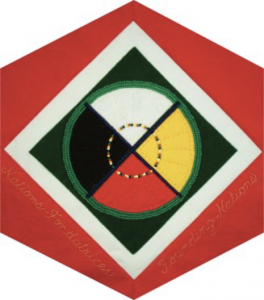Medicine Wheel

The Block
Although Aboriginal nations across Canada may not share the same cultural traditions or religious beliefs, they do have certain things in common, such as a close relationship with the land, respect for the natural environment, and a unique understanding of the circle of life. This block, designed and created by Sue Towndrow, features a symbolic depiction of the circle of life that often appears in varying forms and interpretations – the medicine wheel or sacred hoop. And while it is not a symbol used by all Aboriginal peoples, it is meant to provide representation for all Canada’s First Nations. Green beads, representing the spirit world and Earth are applied on felt and stroud (two fabrics that have been used by First Nations for centuries for clothing and crafts) to surround the circle, which is divided into four quadrants by a double line of blue beads. A single line of colourful beads, representing the “cairn” (a mound of stones), forms a small, inner circle from which fines lines of red beads, the wheel’s “spokes,” radiate. It is felt that one must stand before these “spokes” many times during the circle of life in order to learn life’s lessons, absorb knowledge and fully understand one another.
Cultural Profile
Medicine wheels are stone structures built by North American Natives for various spiritual and ritual purposes. They appear all over the northern United States (specifically South Dakota, Wyoming, and Montana) and southern Canada (Alberta and Saskatchewan), although of the more than 70 that have been discovered, most are located in Alberta. One of the older wheels found has been dated to over 4,500 years old and has been built up by successive generations, who added new features to the circle.
While other ancient peoples are known for erecting massive, towering stone structures (e.g. The Pyramids, Stonehenge), what sets North American Natives apart from them is how very non-intrusive their structures are. Medicine wheels are built by laying out stones on the ground in a circular pattern that often looks like a wagon wheel lying on its side. Most follow the basic pattern of having an outer ring of stones and a smaller inner circle, or cairn, from which lines of rocks, resembling a wheel’s spokes, radiate. Beyond that, however, there are many variations on this simple design and every wheel found has been unique in its style and features. Some wheels are very large, reaching a diameter of more than 22 metres (75 feet), there is no set number of spokes, which may or may not be evenly spaced out, or even all the same length, spokes may emerge from the centre cairn and reach only to the outer ring or, continue past the outer ring. In some the outer ring is broken, with a stone path leading up to the wheel’s centre, while others have various additional circles around the outside of the wheel, at times attached to the spokes or outer ring, or sometimes resting free of the main structure.
In whatever form it appears, the medicine wheel, the symbolic representation of the circle of life, is charged with meaning and wisdom. It is the foundation of the Aboriginal world view and embodies a holistic and earth-centred approach to life in both the physical and metaphysical realms. The number four is central to the wheel, which is divided into four quadrants that together illustrate the balance of life and equality. The four colours begin in the east with yellow and move clockwise to the south (red), west (black), and north (white). The medicine wheel suggests many concepts that are superimposed and interconnected. At the core is the concept of self, as the self is the centre of the universe. Building upon the self are the concepts of the four personalities, the four stages of life, the four aspects of nature, the four directions, the four seasons, the four elements, the four teachings learned by observing nature, the four visionary personality traits, and the four races. The medicine wheel is a model to be used to view one’s self, as well as society. It helps one see exactly where he or she is in life and where one needs to develop in order to reach his or her potential. All the world’s peoples are interconnected and by showing the intricacies of the interwoven threads of life, the medicine wheel helps each understand what their part of the “whole” is and, what it should be.
Sponsor: Medicine Wheel
